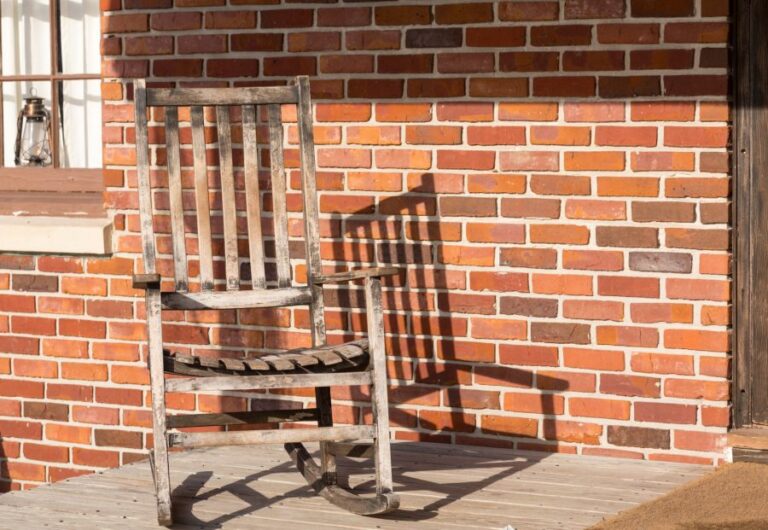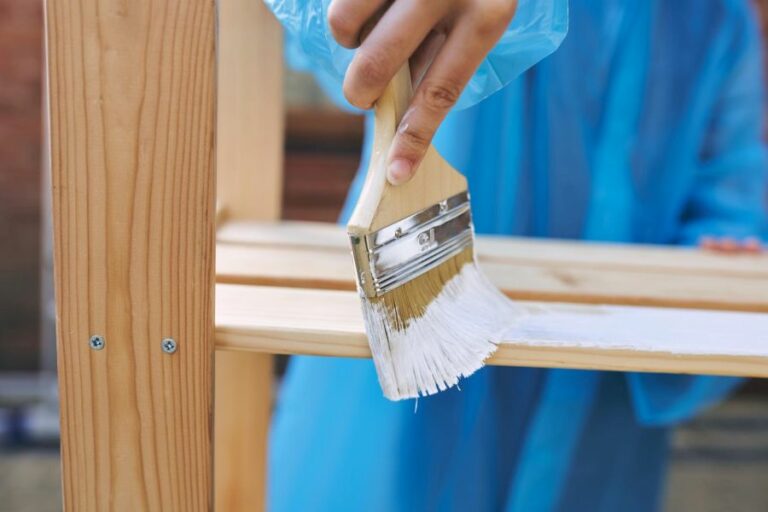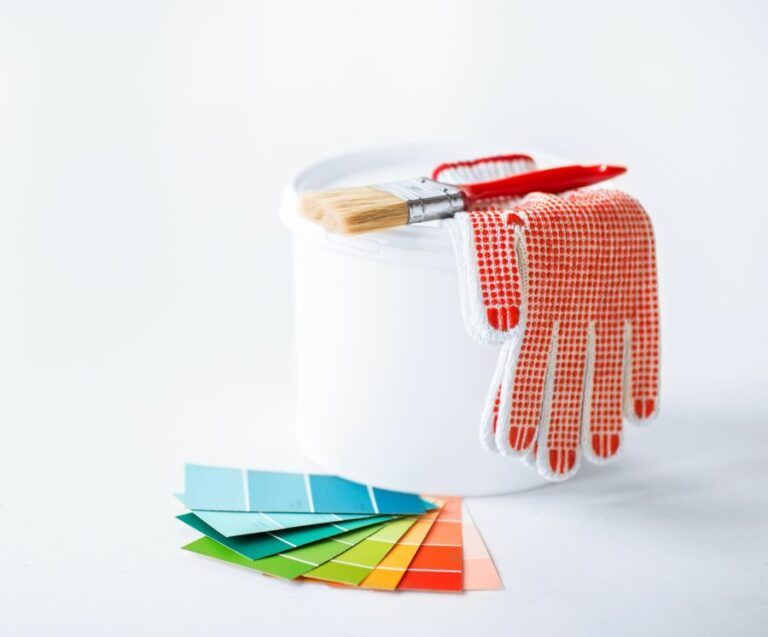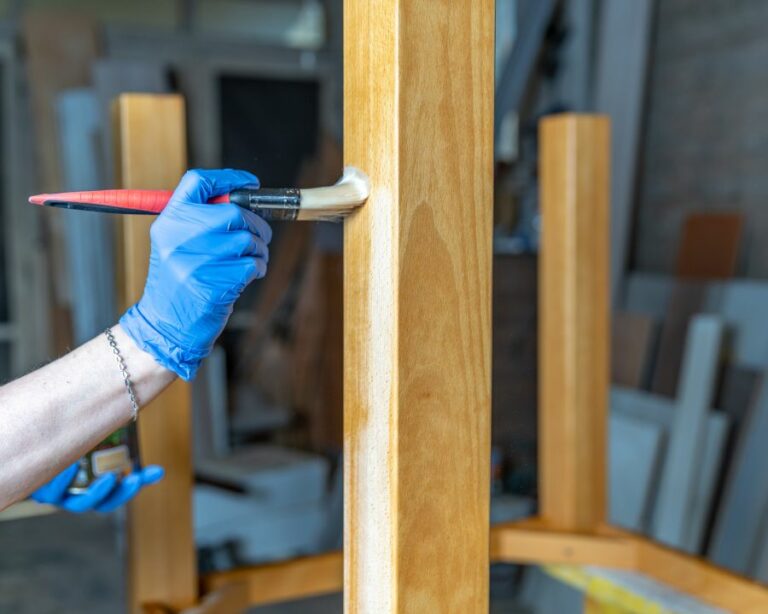Rubberized Outdoor Paint, 25 Things You Should Know
When it comes to ensuring that your outdoor surfaces look great and remain protected against the elements, rubberized outdoor paint might be the perfect solution you’ve been searching for. Luckily, you’ve come to the right place, as I’ve got all the information you need to achieve that desired finish with this versatile paint option.
Rubberized outdoor paint:
Rubberized outdoor paint is a specialized paint containing rubber particles designed for exterior surfaces. It offers several benefits, including weather resistance, waterproofing, slip resistance, and durability. Suitable for various settings, like swimming pools, patios, and playgrounds, it is an ideal alternative to traditional outdoor paint.

Discover the wonders of rubberized outdoor paint! I’ve got all the information you need about this innovative, versatile, and durable paint option. Unveil the secret to perfect exterior surfaces and be amazed by its benefits. You don’t want to miss out on this game-changing solution. Read on!
Contents
- 1 Rubberized Exterior Surface Paint
- 2 What are the applications and uses of rubberized paint?
- 3 What is the optimal paint choice for outdoor rubber surfaces?
- 4 Does Rubberized Paint Possess Waterproof Qualities?
Rubberized Exterior Surface Paint
• What Is Rubberized Outdoor Paint?
Rubberized outdoor paint is a type of paint specifically designed for outdoor surfaces, that contains rubber particles. These particles provide several beneficial qualities, such as waterproofing, slip resistance, and durability.
Rubberized paint is suitable for applications in various settings, such as around swimming pools, patios, decks, and playgrounds.
• Why Use Rubberized Outdoor Paint?
There are several reasons why one might choose to use rubberized outdoor paint over traditional options. Some of these benefits include:
– Weather Resistance
Rubberized outdoor paint is designed to withstand the elements. This means that it can be used on surfaces that are exposed to sunlight, rain, and other weather conditions, without breaking down or becoming damaged.
– Waterproofing
One of the main benefits of rubberized outdoor paint is its ability to create a waterproof surface. This is especially important for surfaces that are frequently exposed to water, such as pool decks and patios.
Applying this paint to these areas helps to prevent long-term water damage and reduces the likelihood of mold and mildew development.
– Slip Resistance
Rubberized outdoor paint provides a slip-resistant surface, which is essential in areas where people walk or play. This is particularly important around swimming pool areas, where wet surfaces can pose a significant safety hazard.
The slip resistance provided by rubberized outdoor paint can greatly reduce the likelihood of accidents in these environments.
– Durability
Rubber particles added to paint increase its durability, making it more resistant to cracking, chipping, and peeling. This means that surfaces painted with rubberized outdoor paint require less frequent maintenance and repainting compared to those painted with traditional outdoor paint.
– Environmentally Friendly
Many types of rubberized outdoor paint are made from recycled rubber materials, which helps to reduce waste and create a more eco-friendly product. This can be an appealing feature for environmentally-conscious consumers.
• How to Apply Rubberized Outdoor Paint
Before applying rubberized outdoor paint, it’s important to ensure that the surface to be painted is clean, dry, and free of any dust, dirt, or debris. If the surface is not properly prepared, the paint may not adhere correctly and could lead to peeling or chipping.
– Step 1: Choose the Right Paint
When selecting a rubberized outdoor paint, it’s essential to choose one specifically designed for the surface you will be painting. Some paints are formulated for use on concrete surfaces, while others may be better suited to wood or other materials.
Reading product labels and consulting with knowledgeable staff at your local hardware or paint store can help you make the correct choice.
– Step 2: Prepare the Surface
Proper surface preparation is key to a successful paint job. Once the surface has been cleaned and dried, any cracks, holes, or rough spots should be repaired or filled with an appropriate filler. For concrete surfaces, it may be necessary to use a concrete primer before applying the rubberized outdoor paint.
– Step 3: Apply the Paint
Rubberized outdoor paint can be applied using a brush, roller, or sprayer. When applying the paint, be sure to follow the manufacturer’s instructions for the specific product you are using. Generally, it is recommended to apply at least two coats of rubberized outdoor paint for optimal results.
– Step 4: Allow Paint to Dry
After the paint has been applied, it is crucial to let it dry according to the manufacturer’s instructions. The drying time may vary depending on factors such as temperature and humidity. In some cases, it may be necessary to wait several days before the surface can be used.
• Caring for Rubberized Outdoor Surfaces
Like any painted surface, regular maintenance is required to keep a rubberized outdoor surface looking its best. This may include regular cleaning, as well as periodic touch-ups or repainting.
– Cleaning
Cleaning a rubberized outdoor surface is generally as simple as hosing it down or using a mild detergent and water solution, scrubbing with a soft brush or sponge, and then rinsing thoroughly.
– Repainting and Touch-Ups
Over time, the rubberized outdoor paint may start to show signs of wear, such as fading or chipping. When this occurs, it’s important to repair any damaged areas and repaint them as needed to maintain the surface’s appearance and protective qualities.
• Safety Considerations
As with any painting project, it’s important to follow proper safety precautions when working with rubberized outdoor paint. This may include wearing protective clothing, such as gloves and goggles, and ensuring that the work area is well-ventilated.
Additionally, it’s essential to store rubberized outdoor paint and any accompanying chemicals in a safe and secure location, away from children and pets.
• Conclusion
Rubberized outdoor paint offers numerous benefits over traditional outdoor paint, making it an ideal choice for many types of outdoor surfaces. Its weather resistance, waterproofing, slip resistance, and durability make it a versatile option for both residential and commercial settings.
What are the applications and uses of rubberized paint?
Being a versatile material, rubberized paint has gained popularity as an innovative solution for protecting, insulating, sealing, and enhancing a wide range of surfaces. With impressive properties, it caters to various industrial, commercial, and residential applications.
• The Properties of Rubberized Paint
Rubberized paint, as the name suggests, consists of rubber particles mixed with a unique paint formula. The result is a flexible, waterproof, and durable coating that adheres remarkably well to different materials. Some of the essential properties of rubberized paint include the following:
- Elasticity: Capable of stretching and returning to its original state without cracking or peeling, it can tolerate structural settling and temperature fluctuations.
- Weather Resistance: Providing protection against external elements such as rain, snow, hail, and ultraviolet rays, rubberized paint can significantly extend the lifespan of a covered surface.
- Waterproofing: Acting as an effective barrier against water permeation, it prevents moisture-related issues such as mold growth, wood rot, and surface damage.
- Sound Insulation: Reducing the transmission of noise and vibrations contributes to a quieter and more comfortable environment.
- Ease of Application: With a convenient application process, it can be easily applied by a spray, roller, or brush, ensuring a seamless and consistent finish.
• Protective Applications of Rubberized Paint
One of the primary uses of rubberized paint is to protect surfaces from various damaging factors. Here are some examples:
– Vehicles and Equipment
Given the various challenges faced by vehicles and equipment, rubberized paint is often recommended as a protective measure. For example, it can shield automotive underbodies and metal surfaces from corrosion, rust, and chipping.
In addition, a rubberized paint layer can be applied as a bedliner in pickup trucks to guard against scratches, scuffs, and dents (U.S. Department of Energy: About Spray-On Bedliners).
Moreover, it serves as a robust and cost-effective solution for protecting industrial machinery and tools.
– Building Exteriors
Rubberized paint can be applied to exterior surfaces of residential and commercial buildings to maintain their aesthetics and structural integrity. It not only safeguards against harsh weather conditions but also ensures that the underlying materials do not deteriorate due to moisture infiltration.
– Marine Structures
Metal and wooden structures exposed to saltwater environments are particularly vulnerable to corrosion and rot. The rubberized paint layer can protect their surfaces, thereby extending their lifespan significantly. This makes it particularly valuable for boats, docks, and coastal constructions.
• Insulating and Sealing Applications
Apart from its protective qualities, rubberized paint has become the go-to solution for insulation and sealing purposes.
– Roofing Solutions
With its impermeable membrane, rubberized paint helps to create a leak-free and energy-efficient roofing system. This coating significantly reduces the rooftop temperature, consequently lowering the overall heat gain to the building.
As a result, it minimizes the cooling load, which can lead to substantial energy savings and lower utility bills (Oak Ridge National Laboratory: Roof Savings Calculator).
– Piping and HVAC
Rubberized paint is an effective solution for insulating and sealing pipes, ducts, and other components of heating, ventilation, and air conditioning (HVAC) systems. By blocking thermal transmission, it prevents energy loss and enhances overall system efficiency.
• Aesthetic and Customizable Uses
Rubberized paint is not just functional but also adds aesthetic value. With an extensive range of colors and finishes, it brings a unique and customized appearance to the surfaces. For example, it can be used on walls, floors, furniture, and various objects to create a visually appealing yet durable surface.
• Conclusion
In conclusion, rubberized paint is a versatile material that offers a wide range of applications and benefits. Its properties of elasticity, weather resistance, waterproofing, and sound insulation make it a valuable choice for various protective, insulating, and aesthetic purposes.
Whether you’re looking to safeguard your vehicle, enhance your building’s exteriors, or create a water-resistant rooftop, rubberized paint is a reliable and cost-effective solution.
What is the optimal paint choice for outdoor rubber surfaces?
Rubber surfaces are commonly used in outdoor settings for their durability, weather-resistant properties, and ease of maintenance. Whether it’s playground equipment, outdoor furniture, or various rubberized structures, giving them a fresh coat of paint can both prolong their life and improve their appearance.
However, it’s essential to choose the right paint to ensure it adheres well and remains vibrant for an extended period.
• Types of Paint Suitable for Rubber
There are several types of paints that work well on rubber surfaces. Some of these include:
1. Acrylic Paint
Acrylic paint is a popular choice for rubber surfaces, known for its flexibility and ability to withstand harsh outdoor conditions. It dries quickly, adheres well to rubber, and creates a smooth finish. Acrylic paint is UV-resistant, meaning it won’t fade easily when sunlight exposes it.
Recommendation: I recommend using water-based acrylic paint specifically designed for rubber or plastics. These paints are more flexible and less likely to crack or peel over time. Brands such as Krylon and Rust-Oleum offer acrylic paint products suitable for rubber surfaces.
2. Spray Paint
Spray paints are an excellent option for larger rubber surfaces, as they offer the convenience of even application and quick drying times. Many spray paints designed for rubber and plastics are available in various finishes, including matte, satin, and gloss, providing you with customization options.
Recommendation: Look for a spray paint specifically formulated for rubber surfaces. Brands like Performix Plasti Dip or Rust-Oleum FlexiDip offer a range of colors and finishes. These types of spray paints create a flexible, durable, and weather-resistant coating for rubber surfaces.
3. Oil-Based Paint
Like acrylic paint, oil-based paint can also be suitable for rubber surfaces. However, oil-based paint tends to dry slower and emit strong fumes, making it less desirable for some users.
Recommendation: If opting for oil-based paint, choose a product specifically formulated for rubber or plastic surfaces. Though less common, such specialized paints can be found in brands like Rust-Oleum or Sherwin-Williams.
• Preparing the Rubber Surface for Painting
Proper surface preparation is crucial to achieving a successful paint job. Follow these steps to ensure the paint adheres well and lasts longer on your rubber surface:
1. Clean the Surface
Thoroughly clean the rubber surface to remove dirt, grime, and any other contaminants. Use a mild detergent mixed with water and a soft brush to scrub the surface. Rinse thoroughly and allow the surface to dry completely before proceeding to the next step.
2. Sand the Surface
Lightly sand the rubber surface using fine-grit sandpaper (around 220-grit) to create a rough texture that will help the paint adhere. Ensure to sand evenly to prevent any uneven paint application. Remove any sanding residue by wiping it with a damp cloth.
3. Apply a Primer
It’s advisable to apply a primer to the rubber surface before painting. A primer will enhance paint adhesion and prevent the paint from peeling or flaking over time.
Choose a primer specifically designed for rubber or plastic surfaces, such as Rust-Oleum Specialty Plastic Primer or Krylon Fusion for Plastic Primer.
• Painting the Rubber Surface
Once the surface has been appropriately prepared, you can begin painting. Follow these steps for a successful paint application:
1. Apply the Paint
Using a brush or a sprayer, apply a thin, even coat of paint to the rubber surface. If using spray paint, maintain the recommended distance from the can to the surface (usually about 10-12 inches) to prevent drips and pooling.
2. Allow the Paint to Dry
After applying the first coat, allow the paint to dry following the manufacturer’s recommended drying time. Acrylic and spray paints typically dry quickly, while oil-based paints may require several hours to dry.
3. Apply Additional Coats
For optimal durability and vibrancy, it’s essential to apply multiple coats of paint. Apply subsequent coats following the manufacturer’s recommended drying time between coats, ensuring the surface is dry to the touch before applying additional paint.
• Care and Maintenance
To keep your painted rubber surfaces looking their best and ensure their longevity, follow these simple maintenance tips:
- Periodically clean the surface with mild soap and water to remove dirt and grime.
- Avoid abrasive cleaners or harsh chemicals that can damage the paint.
- Inspect the painted rubber surface for any signs of chipping or peeling, and touch up the paint as needed.
In conclusion, the best paint for rubber outside depends on factors such as usage, intended aesthetics, and personal preferences. Acrylic and spray paints specifically formulated for rubber surfaces are popular choices, while oil-based paints can also be suitable options.
Proper preparation, application, and maintenance ensure the vitality and longevity of the painted rubber surfaces.
Does Rubberized Paint Possess Waterproof Qualities?
Rubberized paint is a popular choice for waterproofing, especially for surfaces exposed to water, dampness, or humidity. It consists of a rubber-based polymer that forms a flexible and waterproof membrane when dry.
• How Does Rubberized Paint Work?
Rubberized paint works by forming a flexible, rubber-like layer on the substrate’s surface, which provides a barrier against moisture, water, and other elements. This elastomeric layer expands and contracts with the movement of the surface, resulting in excellent protection from cracks and water seepage.
To ensure effective waterproofing, the application process is crucial. It usually involves three essential steps: surface preparation, application, and drying time.
– Surface Preparation
Proper surface preparation is vital to ensure that the rubberized paint adheres well to the substrate. It typically involves:
- Cleaning the surface: Removing dirt, grease, and other contaminants is crucial to ensure a smooth and even application of the rubberized paint.
- Repairing cracks and damages: Identifying and fixing any cracks or damaged areas on the surface prevents further deterioration and ensures a sturdy base for the paint application.
- Priming the surface: A primer is applied to create a uniform surface that enhances the adhesion of the rubberized paint and promotes waterproofing efficiency.
– Application
Rubberized paint is typically available in liquid form and can be applied using a brush, roller, or spray equipment. Depending on the type of rubberized paint used and the specific application instructions, multiple coats may be required to achieve the desired level of waterproofing.
– Drying Time
Allowing sufficient drying time in between coats is crucial as it ensures proper adhesion and the formation of a durable protective layer. Cured rubberized paint can usually be exposed to water within 24 to 48 hours of application.
• Applications of Rubberised Paint
Rubberized paint is versatile and can be used on various surfaces for waterproofing purposes, such as:
- Roofs: The most common application of rubberized paint is for waterproofing flat or low-slope roofs, including metal, built-up, and single-ply roof systems.
- Concrete surfaces: Rubberised paint can be used as a waterproofing solution for foundations, basements, and retaining walls.
- Wood: It can also be used to protect wooden surfaces, such as decks, fences, and outdoor furniture, from water damage and decay.
- Metal: Rubberised paint can be used to prevent rust and corrosion on metal surfaces, including boats, vehicles, machinery, and equipment.
• Advantages of Rubberised Paint
Here are some benefits of using rubberized paint for waterproofing:
- Waterproofing efficiency: Its rubber-like consistency ensures a flexible barrier that is resistant to water, moisture, and humidity.
- Durability: Rubberised paint is known for its long-lasting adherence, with most products lasting up to 10 years or more with proper maintenance.
- Crack resistance: The flexible nature of rubberized paint allows it to expand and contract with the surface, effectively preventing cracks and damages caused by temperature fluctuations or other factors.
- Seamless protection: The application of rubberized paint creates a seamless and continuous waterproofing layer, eliminating the risk of water intrusion through joints or seams.
- Ease of application: Rubberised paint can be easily applied to a variety of surfaces with minimal preparation.
• Limitations of Rubberised Paint
Despite its many advantages, rubberised paint has some limitations, including:
- Limited color options: Most rubberized paint products are available in a limited range of colors, making it challenging to match with the desired aesthetics.
- Sensitivity to UV rays: Some rubberized paints may be susceptible to damage from ultraviolet rays, which can lead to cracks and deterioration over time.
- Compatibility issues: Rubberised paint may not be compatible with all surface materials, and it’s crucial to consult the manufacturer’s guidelines for application recommendations.
• Recommendations for Waterproofing with Rubberised Paint
Based on my experience, I recommend the following practices when using rubberized paint for waterproofing:
- Choose a high-quality product from a reliable manufacturer to ensure optimum performance and longevity.
- Follow the manufacturer’s instructions for surface preparation and application to ensure proper adhesion and waterproofing efficiency.
- Apply multiple coats if necessary to achieve the desired level of protection, allowing sufficient drying time between each layer.
- Regularly monitor the painted surface for any signs of damage, such as cracks or peeling, and address them promptly to maintain the waterproofing effectiveness.
- Consult a professional roofing or waterproofing expert for guidance on choosing the right rubberized paint product for your specific application and surface material.
In conclusion, rubberized paint is an effective waterproofing solution for various surfaces, provided that it is correctly applied and maintained. Follow the above recommendations to enjoy the benefits of a long-lasting and durable waterproofing system.







